Latest recommendations

| Id | Title * ▲ | Authors * | Abstract * | Picture * | Thematic fields * | Recommender | Reviewers | Submission date | |
|---|---|---|---|---|---|---|---|---|---|
15 Dec 2020
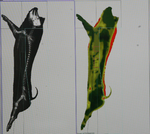
Accuracy of predicting chemical body composition of growing pigs using dual-energy X-ray absorptiometryClaudia Kasper, Patrick Schlegel, Isabel Ruiz-Ascacibar, Peter Stoll, Giuseppe Bee https://doi.org/10.1101/2020.09.15.286153Accurate predictions of chemical composition of pigs for a wide range of body weights: no longer a myth!Recommended by Florence Gondret based on reviews by Mathieu Monziols and 1 anonymous reviewerAssessing body or carcass composition in growing pigs is essential to refine nutritional models, select for specific traits and evaluate pork products. The gold standard methods are dissection and chemical measurements, which are time-consuming and invasive ways to obtain the data. Different teams have tested dual-energy x-ray absorptiometry (DEXA), especially for determining total and regional body composition of fat, soft lean tissues and bone minerals [1-3]. The DEXA measurements are quick, non-invasive, precise, and operator independent. However, the instruments from different manufacturers are unique in implementation so that it is difficult to obtain and share generalized equations. In addition, the validity and accuracy of the measures when applied to pigs having very different composition have been scarcely addressed.
The present manuscript shows that carcass analysis by DEXA can be used to predict empty body chemical composition, and it provides accuracy values for the content in single nutrients (protein, lipids, Ca, P). The body weight range used to generate differences in body composition is very large (20 to 100 kg), which is important when studying pigs along growth. Moreover, regression equations within weight classes (20, 60 and 100 kg) show no important biases, with the exception for body fat especially at the earliest growth stages. Limitations of the technique are the needs of anesthesia when applied to living pigs, and of standardizing the positions of body, carcass and cuts when applied to living or dissected pigs. Another originality of the manuscript is the comparison of the obtained calibrations with previously published prediction models, showing that the differences do not preclude the possibility to use a single model when built from a meta-analysis of the different data. Taken together, this work offers good perspectives to refine nutritional models by inputs from rapidly analyzed body chemical composition and to monitor body and carcass composition in several pigs for genetics applications.
References [1] Mitchell AD., Scholz AM., Pursel VG., and Evock-Clover CM. (1998). Composition analysis of pork carcasses by dual-energy x-ray absorptiometry. Journal of Animal Science. 76(8), 2104-14. https://doi.org/10.2527/1998.7682104x [2] Marcoux M., Bernier JF., and Pomar C. (2003). Estimation of Canadian and European lean yields and composition of pig carcasses by dual-energy X-ray absorptiometry. Meat Science. 63(3), 359-65. https://doi.org/10.1016/S0309-1740(02)00094-3 [3] Kipper M., Marcoux M., Andretta I., and Pomar C. (2018). Repeatability and reproducibility of measurements obtained by dual-energy X-ray absorptiometry on pig carcasses. Journal of Animal Science, 96(5), 2027-2037. https://doi.org/10.1093/jas/skx046 " | Accuracy of predicting chemical body composition of growing pigs using dual-energy X-ray absorptiometry | Claudia Kasper, Patrick Schlegel, Isabel Ruiz-Ascacibar, Peter Stoll, Giuseppe Bee | <p>Studies in animal science assessing nutrient and energy efficiency or determining nutrient requirements necessitate gathering exact measurements of body composition or body nutrient contents. Wet chemical analysis methods or standardized dissec... |  | Agricultural sustainability, Animal nutrition modelling, Monogastrics, Physiology, Pig nutrition | Florence Gondret | 2020-09-17 10:44:58 | View | |
02 Sep 2021

A modelling framework for the prediction of the herd-level probability of infection from longitudinal dataAurélien Madouasse, Mathilde Mercat, Annika van Roon, David Graham, Maria Guelbenzu, Inge Santman Berends, Gerdien van Schaik, Mirjam Nielen, Jenny Frössling, Estelle Ågren, Roger Humphry, Jude Eze, George Gunn, Madeleine Henry, Jörn Gethmann, Simon J. More, Nils Toft, Christine Fourichon https://doi.org/10.1101/2020.07.10.197426Modelling freedom from disease - how do we compare between countries?Recommended by Rowland Raymond Kao based on reviews by Arata Hidano and 1 anonymous reviewerIn this paper, Madouasse et al. (2021) present a generalisable Bayesian method for calculating the probability that a herd is free from disease, based on its prior disease status, and using data (herd status over time over a sufficient number of herds to inform the model) and reasonable prior estimates of the sensitivity and specificity of tests being used to determine animal infection status. Where available, the modelling approach can also include relevant additional risk factors. By bringing all these factors together, it allows for most countries to use the same analytical approach on their data, with differences across datasets expressed in terms of the uncertainty around the central estimates. Having a single methodology that generates both a central estimate of disease freedom, and uncertainty thus provides the opportunity (given typically available data) to compare the probability of freedom across different systems. This is relevant in terms of the context of trade (since international trade of livestock in many cases depends on disease freedom). It is also important when evaluating, for example, transnational burdens of disease - and with different regulations in place in different countries, this is invaluable and can be used, for example, to assess risks of zoonotic infection including for zoonotic infection emergence. In the BVD example provided, the point is made that, since regular testing would probably pick up infection rapidly, the addition of risk factors is most valuable where testing is infrequent. This emphasizes the advantages of direct incorporation of risk factors into a single modelling framework. From a technical point of view, the analysis compares two different packages for the Markov Chain Monte Carlo (MCMC) implementation necesary to run the model. They show that, while there are some slight systematic differences, the estimates provided by the two methods are similar to each other; as one method is approximate but substantially more stable and generally much more computationally efficient, this is an important outcome. Both implementations are freely available and with relevant additional software made similarly available by the authors. This is extremely welcome and should encourage its general adoption across different countries. No single model can of course account for everything. In particular, the reliance on past data means that there is an implicit assumption common to all purely statistical methods that the underlying risks have not changed. Thus projections to altered circumstances (changing underlying risk factors or systematic changes in testing or test performance) cannot so easily be incorporated, since these factors are complicated by the dynamics of infection that lie outside the modelling approach. Of course the well known quote from George Box that "all models are wrong" applies here - the generality of approach, statistical robustness and open source philosophy adopted make this model very useful indeed. Madouasse A, Mercat M, van Roon A, Graham D, Guelbenzu M, Santman Berends I, van Schaik G, Nielen M, Frössling J, Ågren E, Humphry RW, Eze J, Gunn GJ, Henry MK, Gethmann J, More SJ, Toft N, Fourichon C (2021) A modelling framework for the prediction of the herd-level probability of infection from longitudinal data. bioRxiv, 2020.07.10.197426, ver. 6 peer-reviewed and recommended by PCI Animal Science. https://doi.org/10.1101/2020.07.10.197426
| A modelling framework for the prediction of the herd-level probability of infection from longitudinal data | Aurélien Madouasse, Mathilde Mercat, Annika van Roon, David Graham, Maria Guelbenzu, Inge Santman Berends, Gerdien van Schaik, Mirjam Nielen, Jenny Frössling, Estelle Ågren, Roger Humphry, Jude Eze, George Gunn, Madeleine Henry, Jörn Gethmann, Sim... | <p>The collective control programmes (CPs) that exist for many infectious diseases of farm animals rely on the application of diagnostic testing at regular time intervals for the identification of infected animals or herds. The diversity of these ... |  | TEST, Veterinary epidemiology | Rowland Raymond Kao | 2020-07-23 08:13:18 | View | |
29 Jan 2024
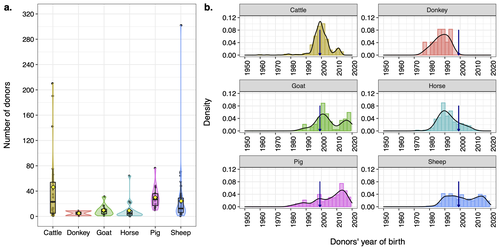
Assessing the potential of germplasm collections for the management of genetic diversity: the case of the French National CryobankAlicia Jacques, Delphine Duclos, Coralie Danchin-Burge, Marie-Jose Mercat, Michele Tixier-Boichard, Gwendal Restoux https://doi.org/10.1101/2023.07.19.549644Exploring Genetic Diversity Management: Unveiling the Potential of Germplasm Collections in the French National CryobankRecommended by Yuliaxis Ramayo-Caldas based on reviews by Roy Costilla and 1 anonymous reviewerThe study by Jacques et al. (2024) addresses a critical concern in the context of genetic diversity erosion in domesticated animal populations. The research uses data from the cryopreserved resources from the French National Cryobank to manage genetic diversity in livestock species. The authors employ a comprehensive methodology to propose novel biodiversity metrics to characterize the status of genetic diversity of cryopreserved collections including cattle, sheep, goat, horse, donkey, and pig livestock species. The findings reveal significant variations of genetic diversity at species and breed levels. Breeds with a large commercial distribution had more donors in the collection than local breeds. The authors propose a practical framework for assessing germplasm collections, providing a valuable tool for planning and managing collections at both national and international levels. The study also highlights the usefulness of the Gini-Simpson and effective donor numbers indices to plan a more efficient sampling, whereas the index of diversity impact can be employed in the selection of the most suitable donors for immediate use, based on pedigree but also using genetic markers. In resume, this study makes a significant contribution to the field by offering a framework for the assessment of germplasm collections. Its innovative metrics provide insights that could guide strategic decision-making in planning, managing, and utilizing cryopreserved resources. This research is relevant and can benefit conservationists, and population genetics working towards the preservation and sustainable use of genetic resources in livestock species. Reference Jacques, A., Duclos, D., Danchin-Burge, C., Mercat, M. J., Tixier-Boichard M., Restoux, G. (2024). Assessing the potential of germplasm collections for the management of genetic diversity: the case of the French National Cryobank. bioRxiv 2023.07.19.549644. ver. 3 peer-reviewed and recommended by Peer Community in Animal Science. https://doi.org/10.1101/2023.07.19.549644
| Assessing the potential of germplasm collections for the management of genetic diversity: the case of the French National Cryobank | Alicia Jacques, Delphine Duclos, Coralie Danchin-Burge, Marie-Jose Mercat, Michele Tixier-Boichard, Gwendal Restoux | <p>Through a combination of selective pressure and genetic drift, there has been a notable erosion of genetic diversity in domesticated animal populations. In response, many countries, including France, have developed gene banks in order to conser... |  | Animal genetics | Yuliaxis Ramayo-Caldas | 2023-07-20 19:08:40 | View | |
27 Jul 2023
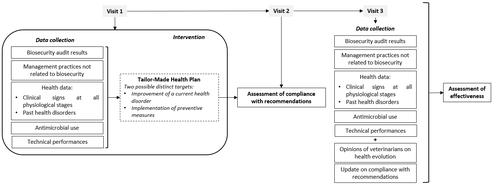
Combining several indicators to assess the effectiveness of tailor-made health plans in pig farmsLevallois Pierre, Leblanc-Maridor Mily, Scollo Annalisa, Ferrari Paolo, Belloc Catherine, Fourichon Christine https://doi.org/10.5281/zenodo.7789634Evaluating tailor-made health plans in pig farms: a multiple complementary indicators approachRecommended by Matteo Chincarini based on reviews by Carla Gomes and 1 anonymous reviewer based on reviews by Carla Gomes and 1 anonymous reviewer
Tailor-made health plans for farming animals, including pigs, are highly beneficial due to their customized nature, addressing the unique needs of each farm and promoting efficient husbandry practices. However, assessing the effectiveness of individualized approaches can be challenging. Levallois et al. (1) tackled this challenge by evaluating the effectiveness of tailor-made health plans of pig farms based on a systematic biosecurity and herd health audit. The study involved twenty farrow-to-finish pig farms, each receiving specific plans tailored to their specific needs. Compliance with the recommendations was monitored over an eight-month period. In the literature, various studies have delved into specific issues in detail, such as disease incidence (e.g., (2)). However, the authors of this research applied a comprehensive approach through an integrative analysis of multiple complementary indicators to provide an effective evaluation of the changes and health disorders. The authors' holistic approach to measuring the effectiveness of tailor-made health plans is noteworthy. They employed up to seven methods to identify advantages and limitations, providing valuable insights for applied research and practitioners in the field of farm animals. Additionally, the study's inclusion of diverse farms, ranging from conventional to antibiotic-free and varying in sow breeding numbers (from 70 to 800), demonstrates the flexibility of the proposed approach, accommodating different farming systems. The study revealed three crucial considerations for future evaluations of tailor-made health plans. Firstly, placing compliance as the primary assessment indicator is a priority. Secondly, it is essential to tailor outcome indicators and monitoring periods according to each farm's specific health disorder. Lastly, a comprehensive understanding of the health disorder's evolution can be achieved through the amalgamation of multiple indicators. While the study does have limitations, such as the relatively short time window for assessment, the methodological framework and results are promising. Further, the discussion of the results raises several areas worthy of future investigation to improve compliance and address farmers' hesitations towards action (i.e., lack of willingness). More research in this context will be beneficial for veterinarians and practitioners, enhancing their understanding and positively impacting both farmers and animals. In conclusion, the study underscores the significant impact of tailor-made health plans on promoting positive changes in farm management. Assessing the effectiveness of these plans enables the refinement of new strategies and enhances the overall quality of work in animal production. The study by Levallois et al (1) sheds valuable light on the challenges and potentials of such plans, providing essential insights for pig farming practices. While further research and improvements are necessary, the study strongly emphasizes the pivotal role of individualized approaches in attaining improved farm management and enhancing animal welfare. 1. Levallois P, Leblanc-Maridor M, Scollo A, Ferrari P, Belloc C, Fourichon C. (2023). Combining several indicators to assess the effectiveness of tailor-made health plans in pig farms. Zenodo, 7789634. ver. 3 peer-reviewed and recommended by Peer Community in Animal Science. https://doi.org/10.5281/zenodo.7789634 2. Collineau L, Rojo-Gimeno C, Léger A, Backhans A, Loesken S, Nielsen EO, Postma M, Emanuelson U, grosse Beilage E, Sjölund M, Wauters E, Stärk KDC, Dewulf J, Belloc C, Krebs S. (2017). Herd-specific interventions to reduce antimicrobial usage in pig production without jeopardising technical and economic performance. Preventive veterinary medicine, 144:167-78. https://doi.org/10.1016/j.prevetmed.2017.05.023 | Combining several indicators to assess the effectiveness of tailor-made health plans in pig farms | Levallois Pierre, Leblanc-Maridor Mily, Scollo Annalisa, Ferrari Paolo, Belloc Catherine, Fourichon Christine | <p style="text-align: justify;">A tailor-made health plan is a set of recommendations for a farmer to achieve and maintain a high health and welfare status. Tailored to each farm, it is intended to be an effective way of triggering change. This st... |  | Animal health, Veterinary science | Matteo Chincarini | 2023-03-31 19:02:35 | View | |
10 Aug 2022
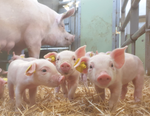
Decreasing the level of hemicelluloses in sow's lactation diet affects the milk composition and post-weaning performance of low birthweight piglets.Francesco Palumbo, Giuseppe Bee, Paolo Trevisi, Marion Girard https://doi.org/10.31220/agriRxiv.2022.00116Varying the hemicellulose content in the diet of lactating sows highlights the importance of early-life interventions for improving health and performance of small piglets during the post-weaning periodRecommended by Florence Gondret based on reviews by Hélène Quesnel and Myriam GrundyOne of the key questions in pig industry nowadays is how health and performance of piglets can be improved by sow nutrition and milk composition. The levels of dietary fibers in sow’s gestation diet have positive effects observed on the litters. However, the composition of dietary fibers and the organization of polysaccharides within the cell wall in the different plants determine their physicochemical properties and, thereby, their behaviour in the gut of the sows and the subsequent physiological response of the animals. Hemicelluloses are polysaccharides constituents of the cell walls of plants, which are fermented in the gut to produce volatile fatty acids (VFA). These VFA can serve as energy source for milk synthesis and can thereby influence the development of suckling piglets. Palumbo and colleagues (1) proposed an original experimental design to compare diets with similar fiber contents but different hemicellulose levels, thanks to varying the sources of fibers used in the dietary formulations. Effects were studied on performance and health of lactating sows and their piglets during suckling period and until post-weaning. The dietary treatments had no effect on the total number of piglets weaned and, consequently, on litter weight at weaning. Milk yield was not influenced by the dietary treatments, but milk composition (lactose content, copper and threonine proportions) was affected by the level of hemicellulose in the maternal diets. With a decreasing hemicellulose level in sow diet, milk lactose content linearly decreased, whereas the copper and threonine contents linearly increased. There was no effect on piglet performance during the lactation period. During the second week of post-weaning, a quadratic increase in the incidence of diarrhoea and the number of days with diarrhoea for suckling piglets was observed with decreasing hemicellulose level in diet. Interestingly, the observed effects were partly different for piglets born with a low body weight. Indeed, there was a linear decrease in the incidence of diarrhoea and days with diarrhoea with decreased hemicellulose level in the maternal diet for those piglets, together with increased growth performance from birth to two weeks post-weaning. The authors postulated that the improved growth performance and the lower incidence of diarrhoea observed in small piglets during post-weaning period may be related to the increased abundance of threonine and copper and increased concentration of total VFA in milk of sows fed a diet with reduced hemicellulose levels. This study confirms the importance of early-life interventions to improve the post-weaning development and health of this sub-population of piglets. Reference (1) Palumbo F, Bee G, Trevisi P, and Girard M. (2022). Decreasing the level of hemicelluloses in sow's lactation diet affects the milk composition and post-weaning performance of low birthweight piglets. agriRxiv 2022.00116, ver 4 (R3), peer-reviewed and recommended by PCI Animal Science. https://doi.org/10.31220/agriRxiv.2022.00116 | Decreasing the level of hemicelluloses in sow's lactation diet affects the milk composition and post-weaning performance of low birthweight piglets. | Francesco Palumbo, Giuseppe Bee, Paolo Trevisi, Marion Girard | <p>Hemicelluloses (HC) are polysaccharides constituents of the cell walls of plants. They are fermented in the gut to produce volatile fatty acids (VFA). The present study investigated the effects of decreasing HC level in sow's lactation diet on ... |  | Pig nutrition | Florence Gondret | 2022-01-21 12:00:22 | View | |
01 Sep 2022
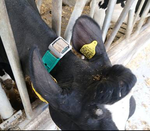
Detecting dairy cows' lying behaviour using noisy 3D ultrawide band positioning dataI. Adriaens, W. Ouweltjes, M. Pastell, E. Ellen, C. Kamphuis https://doi.org/10.5281/zenodo.6627251A novel method to monitor lying behaviour of dairy cows by combining noisy spatial positioning data, time-series segmentation based on statistical changepoints and machine learning classification algorithmRecommended by Eliel Gonzalez-Garcia based on reviews by Kareemah Chopra and John Fredy Ramirez AgudeloUsing on-farm sensors in dairy farming is known to help decision makings and farmer objectives in the monitoring and potential improvement of animal behaviour, health and production performance. However, in indoor positioning systems, data interpretation is complicated by the inaccuracy and noise in the time series, missing data caused not only by sensor failure or the harsh and changing farm environments in which they operate, but also by the animals' specific physiology itself. Thus, working with spatial data has proven challenging mainly due to their enormous heteroscedasticity, which depends on multiple factors such as the cow, the time of the day, the behaviour, factors interfering with the sensor system, etc., for which we cannot account mathematically. Applying purely black-box approaches generally results in insufficient robustness, interpretability and generalisability. With this work, Adriaens et al. (2022) developed a relatively simple and new methodology to monitor the lying behaviour of dairy cows by using noisy spatial positioning data, while combining time-series segmentation based on statistical changepoints and a machine learning classification algorithm. The two-step methodology identifies lying behaviour using an ultra-wide band indoor positioning system. Getting-up or lying-down events were indicated by the accelerometers. Overall classification and lying behaviour prediction performance was above 91% in independent test sets, with a very high consistency across cow-days. The robustness of the algorithm was demonstrated by the fact that both the cow identity-based split and the time-based split performed equally well. The article represents an original contribution for advancing the state of the art in the automated quantification of lying behaviour in dairy cows, aiming to monitor health or animal welfare issues. Future research must be considered however to validate the performance of the model when using different position-measuring technologies, in other farm settings and over a longer period of time.
Reference Adriaens I, Ouweltjes W, Pastell M, Ellen E, Kamphuis C. 2022. Detecting dairy cows' lying behaviour using noisy 3D ultra-wide band positioning data. Zenodo, 6627251, ver. 3 peer-reviewed and recommended by Peer Community in Animal Science. https://doi.org/10.5281/zenodo.6627251
| Detecting dairy cows' lying behaviour using noisy 3D ultrawide band positioning data | I. Adriaens, W. Ouweltjes, M. Pastell, E. Ellen, C. Kamphuis | <p>In precision livestock farming, technology-based solutions are used to monitor and manage<br>livestock and support decisions based on on-farm available data. In this study, we developed<br>a methodology to monitor the lying behaviour of dairy c... |  | Animal behaviour , Mathematical modelling, Precision livestock farming | Eliel Gonzalez-Garcia | 2022-02-28 18:19:37 | View | |
14 Oct 2020
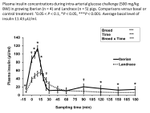
Determining insulin sensitivity from glucose tolerance tests in Iberian and Landrace pigsJ. M. Rodríguez-López, M. Lachica, L. González-Valero, I. Fernández-Fígares https://doi.org/10.1101/2019.12.20.884056Iberian pigs: more than excellent ham!Recommended by Jordi Estellé based on reviews by 2 anonymous reviewersIberian pigs represent a treasured resource that allows the maintenance of their “montanera” traditional breeding system and, thus, contributes to the socioeconomic sustainability of the rural areas in the south-western regions of Iberian Peninsula. While the excellence of Iberian meat products is widely recognized, the idea of using Iberian pigs as biomedical models is currently emerging. Interestingly, due to the particular fatty acid metabolism of this porcine breed, Iberian pigs have been proposed as models for type 2 diabetes (Torres-Rovira et al. 2012) or obesity-related renal disease (Rodríguez et a. 2020). In the present manuscript, Rodríguez-López et al. provide further insights on the particularities of “obese” Iberian pigs by comparing their insulin sensitivity in a glucose tolerance test with that of commercial “lean” Landrace pigs. The authors compared four Iberian pigs with five Landrace pigs in an intense time-series following an intra-arterial glucose tolerance test and measuring insulin, glucose, lactate, triglycerides, cholesterol, creatinine, albumin and urea plasma levels. Several of these parameters showed significant differences between both breeds, with some of them being compatible with an early stage of insulin resistance in Iberian pigs. These results are relevant from an animal production perspective, but provide also further evidence for considering the Iberian pigs as a suitable biomedical model for obesity-related disorders. References [1] Torres-Rovira, L., Astiz, S., Caro, A., Lopez-Bote, C., Ovilo, C., Pallares, P., Perez-Solana, M. L., Sanchez-Sanchez, R., & Gonzalez-Bulnes, A. (2012). Diet-induced swine model with obesity/leptin resistance for the study of metabolic syndrome and type 2 diabetes. The Scientific World Journal, 510149. https://doi.org/10.1100/2012/510149 | Determining insulin sensitivity from glucose tolerance tests in Iberian and Landrace pigs | J. M. Rodríguez-López, M. Lachica, L. González-Valero, I. Fernández-Fígares | <p>As insulin sensitivity may help to explain divergences in growth and body composition between native and modern breeds, metabolic responses to glucose infusion were measured using an intra-arterial glucose tolerance test (IAGTT). Iberian (n = 4... |  | Monogastrics, Physiology, Pig nutrition | Jordi Estellé | 2019-12-28 10:51:03 | View | |
24 May 2024
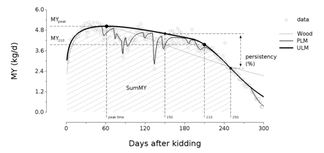
Diversity of performance patterns in dairy goats: multi-scale analysis of the lactation curves of milk yield, body condition score and body weightNicolas Gafsi, Olivier Martin, Fabrice Bidan, Bénédicte Grimard, Laurence Puillet https://doi.org/10.5281/zenodo.10101318Understanding milk and body reserves trajectories and nutrient partitioning in dairy goats through a modelling approachRecommended by Alberto Atzori based on reviews by Kristan Reed and 2 anonymous reviewersThe dairy sector is facing an historical period of high milk demand. However, increasing feed prices continually reduces the economic margins for farms. Managerial strategies to increase economical and technical awareness of animal performance, support the decision chain and optimize the use of production inputs are increasingly necessary, especially in goat farms with intensive production systems. Among the scientific goals, there is a particular emphasis on increasing knowledge about nutrition partitioning between milk production and body reserves — a topic that not easily addressed by nutritional models, limiting the attempts at production forecasting. The paper by Gafsi et al (2024) presents an interesting approach to studying phenotypic traits and trajectories of goat performance. It assesses the diversity of phenotypic trajectories reflecting functions such as milk production, body weight and condition score. This approaches aims to describe, understand and explore the interactions among biological functions and potential trade-offs of phenotypic trajectories across current and successive lactations. The work significantly contributes to the literature, particularly because previous descriptions of lactation curves relied primarily on mathematical outputs lacking information about the relationship among physiologically related variables. The analysis retrieved data from about 1500 goats over more than 20 years and was conducted with a multiscale approach. Data were fitted considering different types of models, including description of perturbations for lactation curves and with multiphasic models for the body weight and body condition score. Synthetic indicators were then estimated with a multivariate approach to define fitted trajectories and changes in performance.
Reference Gafsi N, Martin O, Bidan F, Grimard B, Puillet L (2024) Diversity of performance patterns in dairy goats: multi-scale analysis of the lactation curves of milk yield, body condition score and body weight. Zenodo. 10101318. https://doi.org/10.5281/zenodo.10101318
| Diversity of performance patterns in dairy goats: multi-scale analysis of the lactation curves of milk yield, body condition score and body weight | Nicolas Gafsi, Olivier Martin, Fabrice Bidan, Bénédicte Grimard, Laurence Puillet | <p style="text-align: justify;">In the dairy goat sector, reduced longevity is a key issue leading to higher replacement rates in the herd and a poor dilution of doe rearing costs. There is a need to better understand the determinants of lifetime ... |  | Animal nutrition modelling, Lactation biology , Mathematical modelling, Physiology, Precision livestock farming, Small ruminants | Alberto Atzori | 2023-11-10 12:20:20 | View | |
05 Dec 2019
Effects of feeding treatment on growth rate and performance of primiparous Holstein dairy heifersYannick Le Cozler, Julien Jurquet, Nicolas Bedere https://doi.org/10.1101/760082Optimizing growth rate of dairy heifers through nutrition to maximize reproduction and productionRecommended by Luis Tedeschi based on reviews by Emilio Mauricio Ungerfeld and 2 anonymous reviewers based on reviews by Emilio Mauricio Ungerfeld and 2 anonymous reviewers
The idea of altering the growth rate of replacement heifers to improve reproductive and productive indicators of dairy cattle is not new. In the late 1970s, Gill and Allaire [1] indicated that the first parturition between 22.5 to 23.5 months of age yielded the optimum lifetime performance as long as the heifers had adequate body size [2]. Since 1980s, many studies have been conducted to understand the partitioning of energy between growth and lactation, including the impact of growth rates on the heifer puberty [3] as well as growth and development of the mammary gland [4,5]. The senior author of the recommended study has written previously about this research topic [6]. In the present manuscript, Le Cozler et al. studied the effect of feeding programs to increase the growth rate of late-born heifers to catch up with the growth of those born earlier in the calving season on their reproductive and productive performance. The authors analyzed 217 heifers for three consecutive years, split into three dietary treatments: control (C), accelerated growth rate from birth to 6 months of age (ID1), or accelerated growth rate from birth to 12 months of age (ID2). In this study, the late-born heifers receiving the ID2 treatment were able to partially reach the bodyweight of the early-born heifers at 24 months of age. In part, the incomplete understanding of the prioritization of the use of energy (and other nutrients) for different physiological stages (e.g., maintenance, growth, lactation, and pregnancy) of the dairy animal [7] undercuts the development of more robust feeding strategies to improve the reproductive and productive performance of the animal. In the recommended study by Le Cozler et al., although there was no impact on reproductive performance among groups, heifers in the group ID2 produced less milk (about 400 kg for the whole first lactation) than heifers in the groups C and ID1, apparently suggesting that energy allocation for growth had priority over that needed for lactation. The question then becomes what would have happened with energy partitioning if energy intake was restricted. Studies like this one are important to shed some light on the prioritization of the use of energy and other nutrients in support of growth, pregnancy, and lactation of dairy animals, and how compensatory growth differs between meat versus dairy growing animals, both physiologically and energetically. References [1] Gill, G. S., & Allaire, F. R. (1976). Relationship of Age at First Calving, Days Open, Days Dry, and Herdlife to a Profit function for Dairy Cattle1. Journal of Dairy Science, 59(6), 1131–1139. doi: 10.3168/jds.S0022-0302(76)84333-0 | Effects of feeding treatment on growth rate and performance of primiparous Holstein dairy heifers | Yannick Le Cozler, Julien Jurquet, Nicolas Bedere | <p>The objective of this study was to investigate effects of feeding-rearing programs that aim for first calving at 20-27 months (mo) of age on growth, reproduction and production performance of Holstein cows at nulliparous and primiparous stages.... | Cattle production, Reproduction, Ruminant nutrition | Luis Tedeschi | 2019-09-09 09:22:36 | View | ||
23 Aug 2023
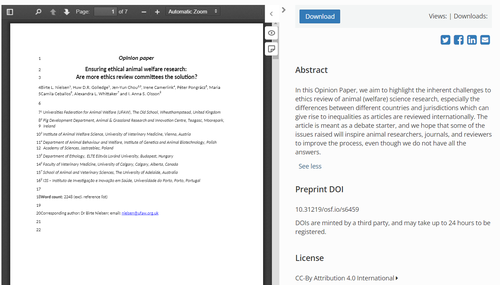
Ensuring ethical animal welfare research: Are more ethics review committees the solution?Birte L. Nielsen, Huw D.R. Golledge, Jen-Yun Chou, Irene Camerlink, Péter Pongrácz, Maria Camila Ceballos, Alexandra L. Whittaker and I. Anna S. Olsson https://www.doi.org/10.31219/osf.io/s6459Can a consensus be reached on the ethical review of animal experimentation for livestock species?Recommended by Hervé Acloque based on reviews by Christian Nawroth, Patrick Gonin and Leon borgdorf"Ensuring ethical animal welfare research: Are more ethics review committees the solution?" by Birte Nielsen and colleagues [1] provides food for thought on the ethical assessment of experiments involving farm animals. While regulations can provide a precise framework, they differ from country to country and do not consider several cases, mainly when the experimentation involves non- or minimally invasive manipulations. It is also the case when research projects use farmed animals that do not fall within the scope of the regulations on animal experimentation but have undergone practices that can be authorised on farms but may raise ethical questions (tail docking, live castration, tooth filing, beak trimming, dehorning). On the other hand, the heterogeneity of the criteria taken into account by the ethics committees, when they exist (and this can differ greatly from one country to another), do not necessarily correspond to the criteria of the journals, the reviewers and the bodies brought in to evaluate the research project, or to the regulations specific to each country. All these paradoxes lead the authors to propose solutions, the most straightforward and spontaneous of which is to ask ourselves questions about this issue upstream of the experimental design required to answer a given scientific question. While increasing the number of ethical review committees may be an insufficient option, the authors insist on the importance of improving committee members' training, taking into consideration jurisdictions' differences between countries and spending more time on ethics evaluation during manuscripts' reviewing. In addition, the upstream assessment of research projects by ethics committees, specific to an institution (research institute, universities, companies), a scientific publisher or even a dedicated international ethical review board may also be a good option. The ethical evaluation of research projects is a question at the heart of our research activities, for which we do not have all the answers. As with scientific reviewing, we must take on the role of evaluator or be evaluated ourselves, using criteria and feelings that are not always consensual. The heterogeneity of evaluation systems within the scientific community, the lack of training for scientists in the fundamentals of ethical evaluation, and the different perceptions of the animal condition between countries and cultures can lead to a reciprocal lack of understanding between evaluator and evaluated, and sometimes a feeling of injustice, as some research may be easy to conduct in one country but difficult in another. Indeed, it is exciting to read the exchanges between the authors and the three reviewers who assessed this opinion paper to appreciate the diversity of points of view and see specific points of divergence. In addition to animal experimentation, the judgment handed down on 30 June 2023 by the French court penalising a pig farmer for the abusive use of an authorised breeding practice (tail docking) is a perfect illustration of the fact that the ethical assessment of practices and handling of farm animals now extends far beyond the scientific world and is becoming an increasingly important factor in the relationship between society and animal breeding. Failure to consider this evolution, whether in experimentation or animal husbandry, may have legal consequences and increase the lack of understanding between our practices and how society perceives them. The questions raised and the solutions proposed in the article by Nielsen et al. are central to our concerns, not only for the scientific community but also to meet the expectations of all stakeholders. Finally, although the authors do not directly address the question of genome editing and research using edited farm animals, this is and will be at the heart of future issues concerning the ethical evaluation of research projects. As with practices and manipulations, the intentionality of the modifications induced leads us to question and evaluate, in farmed species, their consequences on animal welfare and their relevance to society and the development of more sustainable and socially accepted animal husbandry. Reference [1] Nielsen, B. L., Golledge, H. D. R., Chou, J., Camerlink, I., Pongrácz, P., Ceballos, M., Whittaker, A. L., Olsson, I. S. (2023) Ensuring ethical animal welfare research: Are more ethics review committees the solution? OSF Preprints. Ver. 3 peer-reviewed and recommended by Peer Community in Animal Science. https://doi.org/10.31219/osf.io/s6459 | Ensuring ethical animal welfare research: Are more ethics review committees the solution? | Birte L. Nielsen, Huw D.R. Golledge, Jen-Yun Chou, Irene Camerlink, Péter Pongrácz, Maria Camila Ceballos, Alexandra L. Whittaker and I. Anna S. Olsson | <p>As the article is a short Opinion Paper, it has no abstract, but it aims to highlight the inherent challenges to ethics review of animal (welfare) science research, especially the differences between different countries and jurisdictions which ... |  | Animal behaviour , Animal welfare, Open science, Veterinary science | Hervé Acloque | 2023-05-05 13:27:22 | View |
MANAGING BOARD
Karol B Barragán-Fonseca
Mohammed Gagaoua
Rachel Gervais
Florence Gondret
Francois Meurens
Rafael Muñoz-Tamayo
Anna Olsson
Seyed Abbas Rafat
Yuliaxis Ramayo-Caldas









